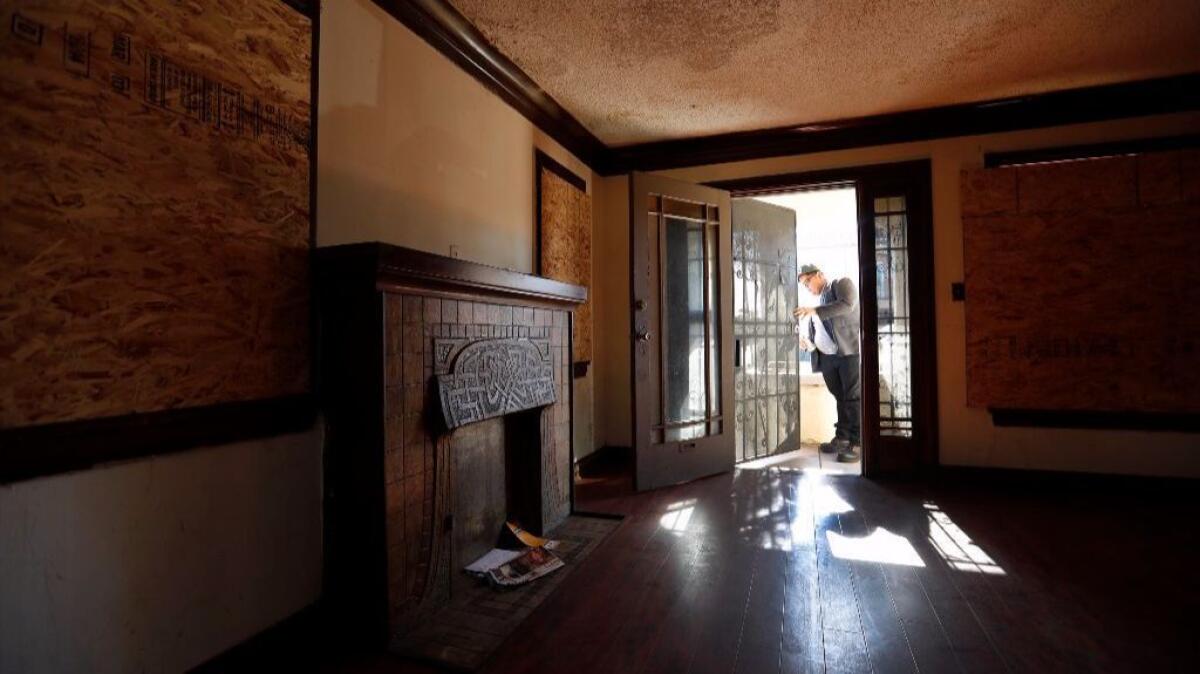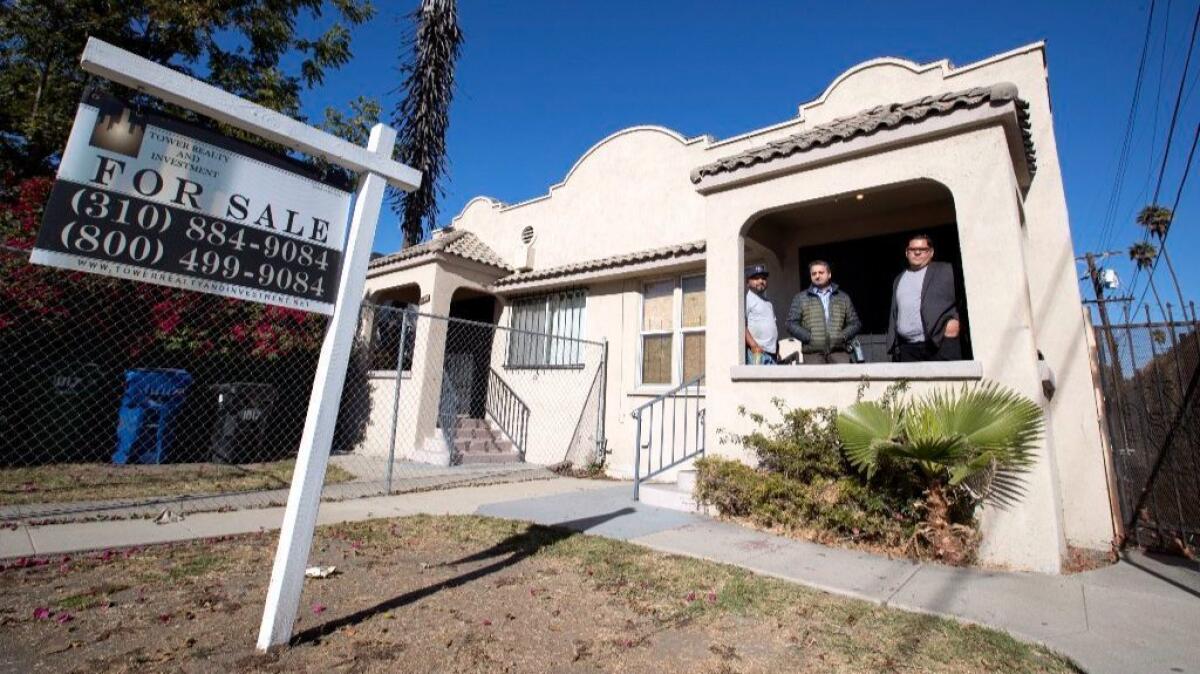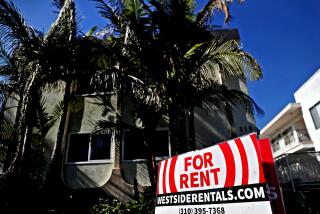Column: Finding the L.A. real estate gold rush — in Compton, Watts and South L.A.

Real estate broker Julio Ruiz, who moved to Compton from San Fernando Valley and is now selling South Los Angeles real estate, shows homes in Watts and South Los Angeles to clients who are looking for a more affordable place to live.
If you were to stand near the corner of 57th Street and South Vermont Avenue, you might not see many great selling points.
But if you were to stand there with Julio Ruiz, you’d get a different take.
He’d point out the nearby transit options, which could get you to USC, downtown, and all the way to the beach.
He’d tell you about all the people moving into the area and all the investors who want a piece of the action.
And he’d tell you this:
“There is cheap housing in L.A. … The American dream is still affordable in Watts, Compton and all the forgotten ghettos.”
Ruiz saw my column last week about frustrated Californians leaving the high-rent districts of coastal Los Angeles for cheaper housing in Las Vegas.

No need to go east, he said, when there’s so much right here. And to prove he’s more than just a pitch man, he offered a few details about himself:
“I have a wife and three kids. We own a home. We moved to Compton from the Valley. I didn’t have to go out of state.”
Ruiz, I discovered, is always on the run and often on the phone. With lenders. With City Hall. With buyers and sellers. He sniffs out investment opportunities and cobbles together deals as he travels by Jeep through neighborhoods where others might fear the crime and gang activity long associated with the South Side, but Ruiz sees nothing but opportunity.
“There’s a buzz all over here,” he said. Houses are getting multiple offers, sometimes all cash, and some are selling above asking prices.
Ralph McLaughlin, chief economist at the online real estate site Trulia, took a quick look at the numbers and said home values in Watts and Compton are at post-recession highs, indicating “increased demand to live or invest” in these areas.
Ruiz said one of his clients is an Asian professor at UC Irvine who bought a three-unit property near USC with plans to live in one unit and rent out the other two. Ruiz also represents a Koreatown couple interested in a $500,000 home in South L.A. because the price would be double that amount where they now live. And he handled one sale in which a white gay couple bought a rehabbed Craftsman near Slauson and Western avenues for just under $500,000.
“One of our neighbors … said she was so happy the gays were moving in because property values would be going up,” said Steven (last name withheld by request), who lives in the house with his partner.
Steven said he’s lived in areas with majority-minority populations before, and that wasn’t a consideration. When he and his partner bought the home, one worked in Hollywood and the other in El Segundo, and they both had relatively easy commutes by bike and transit.
“We have a bunch of friends in Echo Park and Silver Lake, where our money would have gotten us one or two bedrooms. But in our place, we have four bedrooms and three bathrooms,” Steven said.
They don’t have the same social, dining and shopping options, however. And then there’s the nearby prostitution problem. Still, it works for them, if not for everyone.
A housing affordability crisis can change minds, though, and reverse trends. Ruiz said his strategy is to stay “one step ahead of gentrification.” The Olympics are returning in 2028, and the city will want to keep the area around USC cleaned up while knocking down crime, he said. So that’s a solid investment area. So is anything near transit, existing or proposed. The new soccer facility near USC will bring up values. The Rams will lift Inglewood.
“I don’t look at today’s market,” said Ruiz. “I look five years out.”

What about those pushed out?
As much as I admired Ruiz’s hustle and pluck, I had to point out that he’s riding a wave that will lift some people and drown others, particularly low-income minorities.
He argued that he used to work for banks and had to clear squatters, gangs and drug dealers out of houses all over the South Side. Neighbors appreciated the improvements, he said.
“There was an opportunity for people to fix up these houses and for first-time buyers to get in through FHA, VA or different types of loans. As these houses started getting rehabbed, I felt like South L.A. was getting cleaned up,” Ruiz said.
Lots of longtime owners, black and brown, took nice chunks of equity out of those homes and retired somewhere else, he said, adding that he’s putting neighborhood craftsmen to work flipping the houses.
But look at Boyle Heights, I told him. Latinos are being forced out by rising rents.
Boyle Heights vs. Brooklyn Heights
“Boyle Heights used to be Brooklyn Heights,” Ruiz said. “It was Jewish. Neighborhoods are always changing.”
And there will be more “browntrification,” he said. That’s his term for Latinos moving to places like the area around the Jordan Downs housing projects.
“There’s a $5-billion mixed-use development coming in there,” said Ruiz. He showed me a fixer-upper one of his investors bought less than half a block from the projects, anticipating neighborhood improvements and rising property values.
I met up with Ruiz one morning at a duplex on 57th Street, near Vermont, listed at $449,000. He said he and his business partner, Armin Soliemini, had made a cash offer on the house on behalf of some investors, but on the way to check out the property, he got a call tipping him off to another house on the block that was coming up for sale at $310,000.
Just after we arrived on the block, a truck pulled up, hauling a trailer filled with power-washing equipment. I assumed the driver, Rigoberto Galvan, was there to do some maintenance.
I was wrong.
Galvan, who takes the profits from his cleaning and maintenance business and dumps them into real estate, stopped by during his work hours to see if he might want to buy something on 57th Street.
He liked the $310,000 house, which Ruiz saw as a can’t-miss investment. For about $100,000 to $120,000, Ruiz said, the house could be rehabbed, with a granny unit added. And based on comparables in the neighborhood, it would sell for close to $600,000.
But it’s still South L.A., I said. Crime is real, schools are a problem.
It’s risky, no?
“No risk-it, no biscuit,” said Ruiz.
Galvan told me he had been investing in car washes, but the profit margins were marginal.
“Then I met Julio, and he started telling me about different properties,” said Galvan.
Galvan, 38, said he dropped out of school after the ninth grade to work full-time. He said he has bought and sold five properties in South Los Angeles this year alone. His goal is to retire at age 50.
When Galvan left 57th Street, another investor showed up. It was George Janian, the guy who bought, rehabbed and sold the Craftsman to the gay couple. He inspected the duplex inside and out, and talked to the renter, who pays $1,300 a month for one of the duplex’s two units. If he buys the duplex, Janian said, he might sit on it for a while, collecting rent, and maybe sell later.
Ruiz, meanwhile, had already redesigned the vacant unit in his head.
“People want more bedrooms,” he said, and Los Angeles needs more density to address the housing shortage. So he would eliminate the dining room, bump the kitchen into that space, and turn a 2-and-1 into a 3-and-2, possibly with a rear granny unit for added income.
Ruiz showed me two more South Central rehab projects, one owned by Galvan, the other by Ruiz and an Orange County beauty salon operator who has become one of his investors. He noted there were no bars on the windows. These are homes, not prisons.
On the floor of the larger unit in the duplex was a suitcase, a cart and piles of clothing. Ruiz said on a rainy day, he came upon a homeless woman nearby and offered to keep her things dry until she wants them back.
He was briefly on the street himself, he said, back in San Fernando. His father lost his job at a kitchen fixture plant, his parents split, and Ruiz ended up in a one-bedroom apartment with his mother and two siblings. Maybe the reason he’s such a hustler now, he said, is to avoid a replay for his three kids.
The good life in Compton
His house in Compton is on a quiet, tree-lined street, and there’s a big Santa display in the frontyard.
“I wanted each kid to have his own bedroom,” he said as we toured the four-bedroom house he bought two years ago with his speech therapist wife. He figures the house is already into six-figure equity.
“I could’ve moved anywhere,” he said. But for his money, he wouldn’t have gotten a roomy house with a tiny mortgage, proximity to work and shopping, and a few bucks in his pocket.
“I’ve got my oldest kid in private school,” he said, “and we’ve got year-round passes to Disneyland.”
He’s living his dream — and he earned it.
But private schools and Disneyland passes are out of reach for many. And what do we do when even Compton becomes unaffordable?
Get more of Steve Lopez’s work and follow him on Twitter @LATstevelopez
More to Read
Start your day right
Sign up for Essential California for news, features and recommendations from the L.A. Times and beyond in your inbox six days a week.
You may occasionally receive promotional content from the Los Angeles Times.







